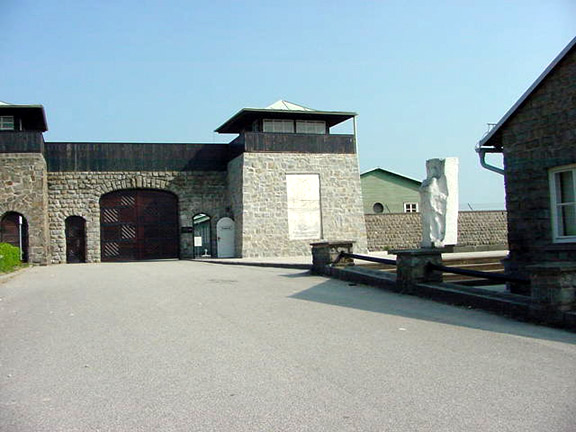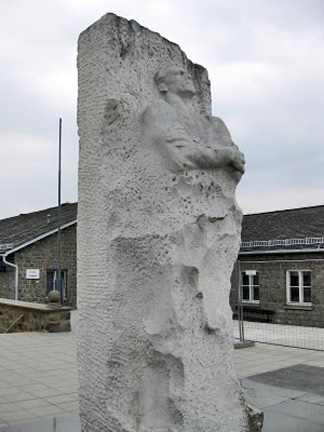Mauthausen Memorials This photo was taken from outside the gate into the prison compound; the wide road that leads up from the quarry is shown in the foreground. On the right is a large white marble memorial stone in honor of Lt. Gen. Dmitry Mikhailovich Karbyshev, a Soviet Prisoner of War who was allegedly murdered at Mauthausen in February 1945. Behind the statue, on the lower level of the camp and not visible in this photo, is the garage yard where prisoners had to stand naked for hours while their clothes were being disinfected in an effort to control the lice which spreads typhus.  Karbyshev was a prominent Soviet military engineer, and a graduate of the Omsk Military School, who was captured only one month after the German Army invaded Russia on June 22, 1941. Between 1941 and 1945, he was sent to 13 different prisons and camps including two different POW camps on the eastern front before being transferred to the Flossenbürg concentration camp in Germany. Allegedly he was treated well at first because the Gestapo wanted to recruit him for the infamous "Red Army of Liberation." This was a division of the German army composed of Russian traitors commanded by General Vlasov, according to Christian Bernadac, author of "The 186 Steps." Karbyshev was a veteran of several wars and an expert on military fortifications. Karbyshev refused to betray his country and fight against the Communists on the side of the Hitlerites, as two million of his countrymen did. He was then moved around to several other camps, spending time at the two major deaths camps in Poland (Majdanek and Auschwitz) before being transferred to the Sachsenhausen concentration camp near Berlin. Finally, he was sent to Mauthausen, the worst camp in the Nazi concentration camp system. Mauthausen was the final destination of POWs who had attempted escape and had been recaptured, but there is nothing about any escape attempt in the story of General Karbyshev. On the night of February 2, 1945, there was a daring escape from Block 20, the barracks for condemned prisoners at Mauthausen. According to Bernadac, Block 20 was for "incorrigibles" or "prisoners who had made repeated efforts to escape; men convicted of sabotage; men guilty of anti-Hitler propaganda. Almost all of them were Soviet citizens." Around 600 to 700 prisoners from Block 20 succeeded in storming the guard towers and escaping over the wall, but there were only nine who made it to safety. The others were hunted down by the SS, with the help of Austrian civilians who answered the call to help find the escapees and kill them. A few Austrian civilians hid some of the escapees in their barns or attics until Mauthausen was liberated. Christian Bernadac gives a detailed account of the escape in his book "The 186 Steps" but he does not mention Karbyshev as one of those who participated in the escape, nor does he mention that Karbyshev was among the condemned prisoners in Block 20. In fact, Bernadac doesn't mention Karbyshev at all in his very detailed book which is chock full of the names of his fellow prisoners. A couple of weeks later, after the famous escape from Block 20, Karbyshev was selected along with a group of other prisoners. The date and the number of men selected varies according to who is telling the story, but it was either the 16th, 17th or 18th of February and the number of victims was between 200 and 400. Allegedly Karbyshev and the others were forced to stand naked for three hours in the garage yard and were then forced to take a cold shower. One version of the story says that Karbyshev refused to stand under the cold water and was beaten to death in the shower. The Mauthausen Museum version says that he was forced to stand outside all night while cold water was poured over him. Karbyshev was 64 years old when he died; he was posthumously made a Hero of the Soviet Union in 1946. General Karbyshev has become a legend; streets and ships are named after him and the story of his death by torture is retold on the anniversary of the liberation of the camp and in annual celebrations of the Soviet victory in World War II. The monument to him shows him encased in a block of ice. Memorial for Dutch & British AgentsPrivate Memorials at MauthausenJewish MemorialsHungarian and Bulgarian MemorialsGDR (East Germany) MemorialAlbanian MemorialHome |